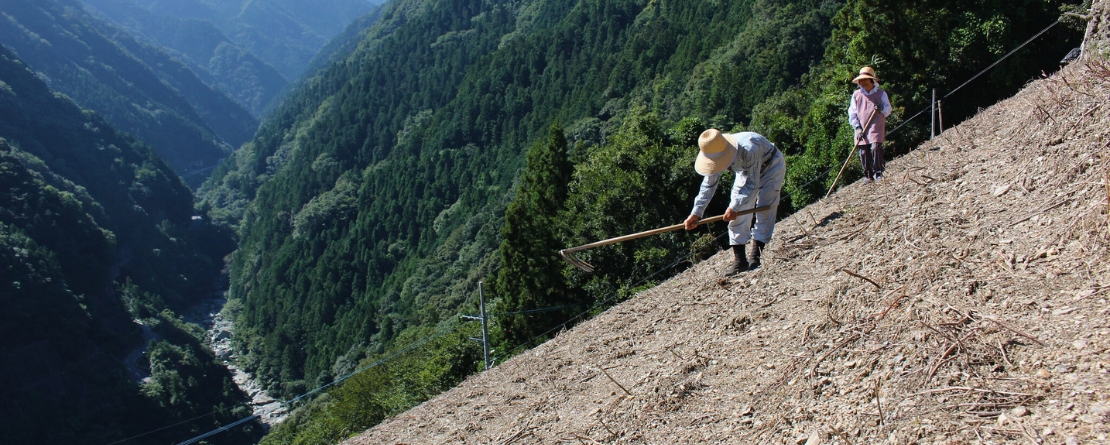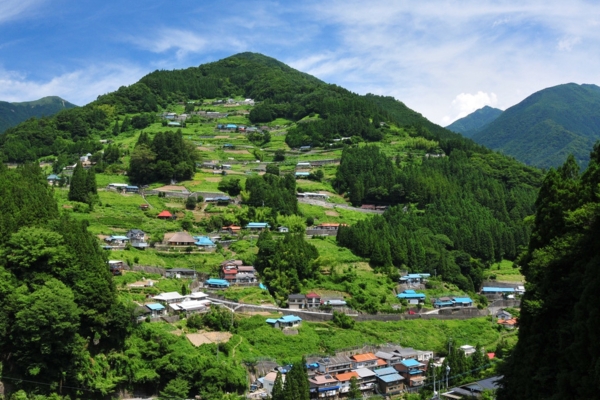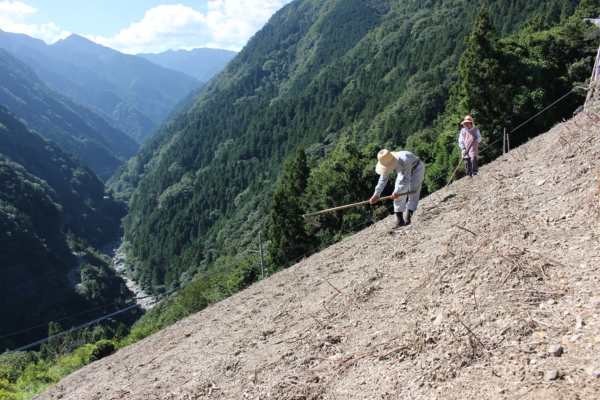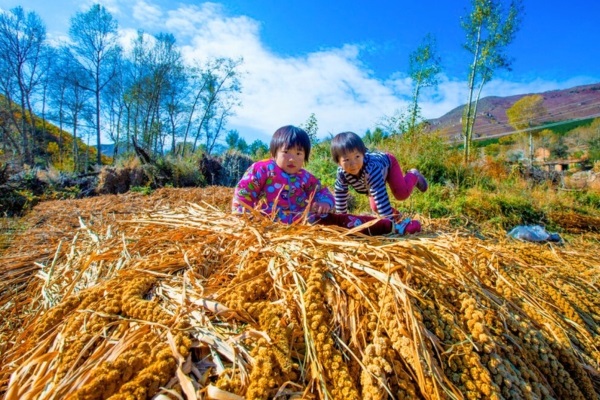Nishi-Awa Steep Slope Land Agriculture System, Japan
GIAHS since 2018

©Tokushima-Mt. Tsurugi GIAHS Promotion Association
The Nishi-Awa agricultural system is characterized by a land management system that utilizes mountain slopes with versatility, and the history is said to date back to 300BC. The variety of indigenous grains can be cultivated even in infertile soil. Grasslands established around sloping fields preserves biodiversity and maintains the ecosystem.
Global importance
This System is full of wisdom for enabling people to continue to live abundant lives through agriculture by adapting flexibly to the natural environment, weather disasters, and social changes under the harsh conditions of steep slope land.
Moreover, the area’s agricultural methods that have been passed down over generations and genetic resources for grains that can be cultivated even in infertile soil have the potential to be of use in resolving the world’s food problems.
In these terms, the System is thought to have the potential to provide hints for resolving various issues facing humankind with respect to the vulnerability of global agriculture as the simplification of staple crops progresses and resilience through diversified staple food cultivation, thereby greatly contributing to the world.
Food and livelihood security
The Nishi-Awa Steep Slope Agriculture System is currently supported by small-scale farmers comprising mainly women and elderly people. Although the area of cultivation per farm is small, a large variety of grains and vegetables are grown. This produce is not only consumed by the farmers themselves but also shared with relatives and neighbours, or exchanged for rice or meat, providing economic effects that cannot be calculated in monetary terms.
In addition to continuing to grow these native genetic resources, the residents cultivate small quantities of a large variety of foods, including buckwheat, Asian royal fern, tea, fruit trees, and vegetables. This produce is shipped to Japan Agricultural Cooperatives (JA) and 30 or so farmers’ markets, providing a source of income. Furthermore, the grasslands that are essential for maintaining the sloping fields are home to various rare plants and animals, contributing to the preservation of biodiversity. Furthermore, indigenous varieties of grains and potatoes continue to be cultivated and used due to home production of seeds, firmly supporting the unique food culture that is a regional attraction notably for tourism activities.
Agrobiodiversity
Even now, cultivation of a diversity of varieties is continuing, with a large number of indigenous varieties such as Japanese barnyard millet, foxtail millet, proso millet, finger millet, great millet, and buckwheat existing, and so the area also has the function of a so-called “gene bank.”
In the Nishi-Awa area, grasslands are established around sloping fields mainly for the purpose of providing kaya to be used for laying over the soil or as mulch. These grasslands play a significant role in the preservation of biodiversity and maintenance of the ecosystem. Preservation of the biodiversity of these grasslands has been continued precisely because it is an agricultural activity that is the foundation of field cultivation. The sloping fields also provide an important habitat for many insects, as well as birds that feed on them and various other animals.
Local and traditional knowledge systems
In the Nishi-Awa area, a unique technique is used to protect the subsoil and continue agricultural activities whereby kaya (Chinese silvergrass and other grasses) from grasslands are dried and cut into short lengths and plowed into the soil as well as laid on the soil surface. In terms of soil ecology, this application of kaya has the effects of (1) preventing erosion and runoff of soil and fertilizer; (2) supplying organic matter; (3) regulating soil temperature, keeping the soil at a uniform temperature (Figure 9); (4) preserving soil composition; (5) preserving the soil’s moisture content; and (6) controlling weed growth, etc.
As a general rule, the fields in slope land villages use the mountain slopes as is, without building terraces, but depending on the topography, stone walls are built in order to lessen the steep incline and reduce the impact of soil erosion. Furthermore, effective techniques utilizing the radiation heat reflected off the stone walls have also been incorporated into the cultivation of tomatoes and other vegetables.
Accordingly, measures have been implemented to preserve the soil using excellent drainage management techniques under the Nishi-Awa Steep Slope Agriculture System. The first of these is to build ridges along contours (both stripping and planting), thereby achieving a dam effect that prevents soil runoff due to rain.
Cultures, value systems and social organisations
The large diversity of grain, vegetable, and fruit varieties produced in sloping land fields supports the daily lives of the people in these settlements during the harsh winter and all year round in the form of preserved foods prepared by each household through such methods as sun-drying, or are shipped for sale as richly flavoured and nutritious regional specialties.
In the Nishi-Awa area, a diversity of agricultural festivals and events has been passed down over generations in each district as important cultural activities supporting sloping land agriculture. These not only include ritualistic aspects such as praying for rain, but also have the important function of sustaining and strengthening relationships amongst the local residents involved in sloping land agriculture. Looking forward to these festivals and events has provided farmers with motivation for continuing what at times can be arduous farm work.
Landscapes and seascapes features
The greatest characteristic of the Nishi-Awa landscape is that housing, fields, grasslands, and forest are functionally distributed over sloping land in an integrated manner—an arrangement that appears inconvenient at first glance—rather than separating fields/paddies and grasslands from housing, as is the case in other areas. Compactly bringing together these various elements, Nishi-Awa’s multiple-function settlements create a uniquely beautiful mosaic landscape.
Under the Nishi-Awa Steep Slope Agriculture System, an essential technique used to prevent soil erosion from sloping fields is spreading kaya that has been harvested from grasslands and dried over the soil. Furthermore, in the Nishi-Awa area the conical stacks of kaya are referred to as koeguro or guro. These can be observed all year round, and are an important element of the unique landscape of sloping land settlements.
Proposal

Proposal: Nishi-Awa Steep Slope Land Agriculture System
05/02/2018
Agriculture in this area is characterized by a land management system that utilizes mountain slopes with versatility. Top soil is shallow, and in places the steepness of slopes is as much as 40 degrees.
Action plan

Action plan: Nishi-Awa Steep Slope Land Agriculture System
05/02/2018
This Action Plan summarizes the ongoing and planned projects in the Nishi-Awa Steep Slope Land Agriculture System, the subject of the Tokushima-Mt. Tsurugi GIAHS Promotion Association’s application for recognition as a Globally Important Agricultural Heritage System (GIAHS) by the United Nations Food and Agriculture Organization (FAO).
Multimedia
.tmb-th600x400.jpg?Culture=en&sfvrsn=b4559b6d_3)
Photos
Flickr Album: Nishi-Awa Steep Slope Land Agriculture System, Japan
24/07/2011
Agriculture in this area is characterized by a land management system that utilizes mountain slopes with versatility. It is currently supported by small-scale...
Video
Steep Slope Land Agriculture System in Nishi Awa
23/06/2017
The history of the Nishi-Awa Steep Slope Land Agriculture System is said to date back to shifting cultivation (slash-and-burn agriculture) in the latter...
Highlights
28/ 11
2022
30/11
2022
International Symposium on GIAHS and Family Farming
(Japan), Hybrid Event, 28/11/2022 - 30/11/2022
This year´s International Symposium will be organized in a hybrid style to focus on concrete activities implemented by family famers in GIAHS sites, related to the promotion and marketing of their agricultural products through various methods and approaches (e.g., labelling or certification systems, exploration of new supply chain, new demand, niche market, etc.).
26/ 1
2021
Globally Important Agricultural Heritage Systems: an opportunity to restore ecosystems and achieve the SDGs
Virtual Event, 26/01/2021
GIAHS site representatives from China, Japan, Peru, Morocco, Spain and Tanzania shared their experiences and challenges on the sustainable use of natural resources as well as the types and functions of their ecosystem services. They explored how GIAHS can contribute to the objectives of the UN Decade on Ecosystem Restoration.


